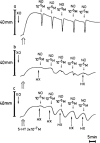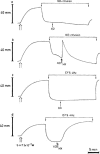Interaction of hypoxanthine/xanthine oxidase with nitrergic relaxation in the porcine gastric fundus
- PMID: 10807674
- PMCID: PMC1572077
- DOI: 10.1038/sj.bjp.0703317
Interaction of hypoxanthine/xanthine oxidase with nitrergic relaxation in the porcine gastric fundus
Abstract
The influence of hypoxanthine (HX)/xanthine oxidase (XO) on short-term [electrical field stimulation (EFS; 4 Hz) for 10 s and 3 min; bolus of exogenous NO (10(-5) M)] and long-term [EFS (4 Hz) and continuous NO-infusion for 20 min] nitrergic relaxations was investigated in circular muscle strips of the pig gastric fundus. HX (3x10(-4) M) / XO (64 mu ml(-1)) did not affect EFS for 10 s and 3 min; the short-lasting relaxation in response to a bolus of exogenous NO (10(-5) M) was changed into a biphasic relaxation with a small and short first phase followed by a larger and prolonged second phase. Cu/Zn superoxide dismutase (Cu/Zn SOD; 1000 u ml(-1)) and uricase (100 mu ml(-1)) respectively enhanced the amplitude of the first phase and diminished the amplitude of the second phase. Ascorbate (5x10(-4) M) and bilirubin (2x10(-4) M) prevented the prolonged component. Exposure to HX/XO during long-term EFS elicited a complete, stable reversal of relaxation starting after a delay. During continuous NO-infusion, HX/XO induced an immediate, complete but transient reversal. The antioxidants bilirubin, ascorbate, alpha-tocopherol, urate, glutathione and Cu/Zn SOD, the hydrogen peroxide degrading enzyme catalase, the hydroxyl radical scavengers dimethylsulphoxide and mannitol, and the cofactor flavin adenine dinucleotide did not influence the reversal induced by HX/XO during either EFS or NO-infusion. The cell-permeable manganese SOD mimetic EUK-8 modified the stable reversal during long-term EFS into a transient one. The results suggest that a nitrated uric acid derivative is responsible for the prolonged second phase in the relaxation to a bolus of exogenous NO in the presence of HX/XO. The exact underlying mechanism of the reversal induced by HX/XO during sustained relaxation remains unclear.
Figures






Similar articles
-
Influence of bilirubin and other antioxidants on nitrergic relaxation in the pig gastric fundus.Br J Pharmacol. 2000 Mar;129(6):1201-11. doi: 10.1038/sj.bjp.0703176. Br J Pharmacol. 2000. PMID: 10725269 Free PMC article.
-
Role of superoxide dismutase enzymes and ascorbate in protection of nitrergic relaxation against superoxide anions in mouse duodenum.Acta Pharmacol Sin. 2008 Jun;29(6):687-97. doi: 10.1111/j.1745-7254.2008.00802.x. Acta Pharmacol Sin. 2008. PMID: 18501115
-
Influence of polyethylene-glycol-superoxide dismutase and combined depletion and repletion of antioxidants on nitrergic relaxation in the pig gastric fundus.Eur J Pharmacol. 2004 Feb 20;486(2):223-32. doi: 10.1016/j.ejphar.2003.12.024. Eur J Pharmacol. 2004. PMID: 14975711
-
Role of antioxidants in the protection of the nitrergic neurotransmitter.Acta Neurol Belg. 2002 Jun;102(2):68-72. Acta Neurol Belg. 2002. PMID: 12161902 Review.
-
Superoxide anions, free-radical scavengers, and nitrergic neurotransmission.Gen Pharmacol. 1997 Apr;28(4):489-93. doi: 10.1016/s0306-3623(96)00281-9. Gen Pharmacol. 1997. PMID: 9147013 Review.
Cited by
-
Role of APE1 in differentiated neuroblastoma SH-SY5Y cells in response to oxidative stress: use of APE1 small molecule inhibitors to delineate APE1 functions.DNA Repair (Amst). 2009 Nov 2;8(11):1273-82. doi: 10.1016/j.dnarep.2009.08.003. Epub 2009 Sep 1. DNA Repair (Amst). 2009. PMID: 19726241 Free PMC article.
-
Hydrogen sulfide chemical biology: pathophysiological roles and detection.Nitric Oxide. 2013 Nov 30;35:5-20. doi: 10.1016/j.niox.2013.07.002. Epub 2013 Jul 9. Nitric Oxide. 2013. PMID: 23850632 Free PMC article. Review.
-
Dose-dependent effects of allopurinol on human foreskin fibroblast cells and human umbilical vein endothelial cells under hypoxia.PLoS One. 2015 Apr 1;10(4):e0123649. doi: 10.1371/journal.pone.0123649. eCollection 2015. PLoS One. 2015. PMID: 25830774 Free PMC article.
References
-
- BARBIER A.J.M., LEFEBVRE R.A. Effect of LY83583 on relaxation induced by non-adrenergic non-cholinergic nerve stimulation and exogenous nitric oxide in the rat gastric fundus. Eur. J. Pharmacol. 1992;219:331–334. - PubMed
-
- BECKER B.F. Towards the physiological function of uric acid. Free Rad. Biol. Med. 1993;14:615–631. - PubMed
Publication types
MeSH terms
Substances
LinkOut - more resources
Full Text Sources
Research Materials

